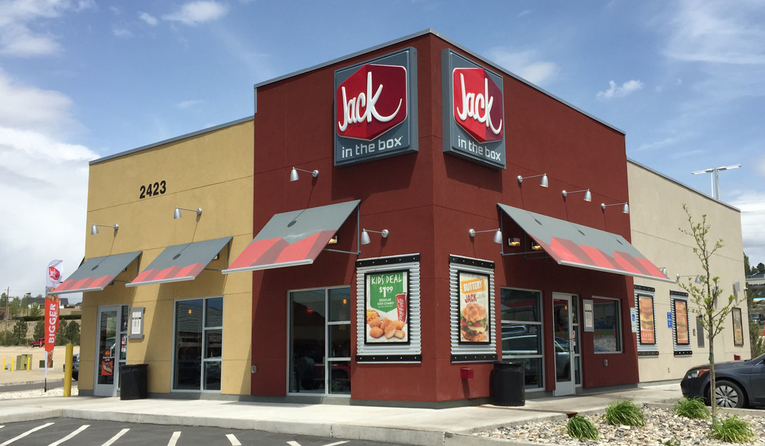Jack in the Box CEO Leonard Comma and his team know the quick-service industry is ready to heat up.
There will be battles to gain market share and encroachment into competitors’ spaces. However, Comma added Jack in the Box is more than just a burger and fries brand. With a focus on speed of service and menu innovation—both value and indulgent—the CEO believes his chain is prepared for whatever food war comes its way.
“We’ve been a 24/7 player that provides food well outside of just burgers, fries, and drinks,” Comma said during the company’s Q1 earning’s call. “And the consumer has come to value us for that over time, so we would expect that as the competitive set continues to sort of grow their menus or their dayparts that we will have an answer. And as far as the breakfast intrusion that we’re seeing today or some of the competitive things that are happening around breakfast, we have a calendar that’s ready to compete within the marketplace with some of our best breakfast lineups, and that’s what we think is going to be necessary at this time.”
Leading the charge of that menu innovation are Jack in the Box’s Tiny Tacos, which became a permanent item in January. Comma said the item helped recover some value-oriented customers after the brand raised its price ceiling for the Two Tacos deal a few years ago.
Comma noted Tiny Tacos are inexpensive to produce and easy to deliver, and compared them to potato chips, saying “they’re the type of food that you eat like potato chips. You can’t just eat one.”
But the CEO remains cautious, and doesn’t want the brand to “bet the farm on Tiny Tacos.” In addition, he recognizes innovation must continue and that there’s no silver bullet product.
“So, our most fickle and least loyal consumer is the consumer that’s looking for purchases below the $5 mark,” Comma said. “And I think what you’re seeing is that we’re able to capture back some of those consumers. Those consumers do like Jack in the Box, but they’re deal shoppers. And if you don’t have a deal out there, they’re not going to participate. We’re also doing a lot of upselling because the way that the promotions are created, we’re allowing the sandwiches to be upsized, and we’re also creating, oftentimes, a side or a snack that can be upsold and added to the meal. And that’s worked out very favorably as well. So that’s sort of what’s driving some of the improvement in transactions versus prior year trends, and we think that’s something we’re going to need to continue doing.”
Other innovation includes the $1 cereal milk donut holes and values offers like the two for $3 Breakfast Jacks, featuring a new Chicken Breakfast Jack. Jack in the Box also featured indulgent sides like the $3 soft and loaded fries and the new $3 mini munchies, which helped raise the average check.
The brand—which attributed a growth in sales to bundles and innovation—has climbed back into positive same-store sales in Q1 year-over-year. System-wide, comp numbers rose 1.7 percent (2,244 total units) compared to a 0.1-percent decline last year. Company-owned stores (137 locations) saw a 2.9-percent uptick, while franchised units (2,107 locations) grew 1.6 percent. The corporate figures were driven by a 2.6-percent growth in average check and 0.3-percent increase in transactions. Revenue grew to $307.7 million in Q1 year-over year.
“They’re helping them to operate a little faster and generate some throughput through their drive thru,” Comma said of recent changes. “And I think that it’s given us optimism about our franchisees following behind and making some of the same improvement.”
While Jack in the Box continues to innovate its products, it also plans to serve said products in a more efficient manner. The goal is to reduce speed of service by one minute by 2021, which began with the hiring of Chief Operating Officer Marcus Tom two years ago. For example, Comma said, the brand found better ways to maintain protein at a high quality so that operators aren’t rushing through the just-in-time cooking and preparation process. The CEO said it adds ease to operations.
He noted that the higher increase in corporate comp sales is related to those stores being early adopters of the changes.
“They’re helping them to operate a little faster and generate some throughput through their drive thru,” Comma said. “And I think that it’s given us optimism about our franchisees following behind and making some of the same improvement.”
The brand also continues to investment in digital and delivery. Mobile pay is still a low percentage of sales, but Comma noted that users and transactions grow with each quarter. More than 95 percent of stores are partnered with at least one third-party delivery company. Jack in the Box completed the integration of Grubhub into its point-of-sales system and is working on doing the same for third parties, as well.
The chain expects system-wide same-store sales growth of between 1.5 to 3 percent in fiscal year 2020 and the opening of 25 to 35 new restaurants, most of which will be franchised.
Comma declined to share specifics about product launches in the coming year, but he showed excitement for what Jack in the Box has planned.
“Part of the optimism we have around our guidance for this year has to do with that,” Comma said. “We spoke about that a little bit at the end of Q4 as folks were wondering about the Q1 results. We spoke about looking at the entire year and our optimism around all the initiatives, including the new products that are going to be rolled out as contributing to that. So we still feel strongly about it. We’ll move forward with some of the things we mentioned in the past. The timing is still to be determined as those tests conclude, but we’re pretty optimistic about what we’ve got planned.”

